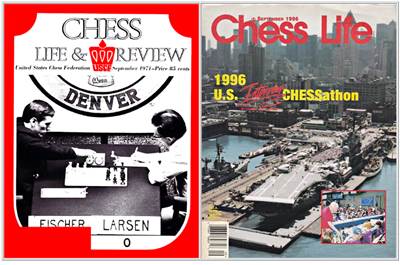September 1971 & 1996 'On the Cover'
Going back a month to August 1971 & 1996 'On the Cover' (August 2021), I wrote,
Last month's 'On the Cover' composite photo, covering the months July 1971 & 1996, showed a World Championship encounter on the left and an important U.S. tournament on the right. A month later, the focus was switched.
Copy that to the current month, where we once again have 'a World Championship encounter on the left and an important U.S. tournament on the right'. Then change 'important U.S. *tournament*' to 'important U.S. *event*' and the switcheroo is complete.

Left: '?'
Right: '1996 U.S. Interplay CHESSathon'
Chess Life & Review (50 Years Ago)
Fischer and Larsen during the fifth game of the sensational match at Temple Buell College, Denver. The games appear [inside]. Photo by Dave Cornwell.
Although Fischer's score in the match is obscured by a mailing label on the cover, the story inside -- 'Fischer Does It Again, 6-0!!' by Burt Hochberg -- sets the record straight. The story started,
Bobby Fischer continues to astound. Since he was a boy, he has amazed the chess world with his exploits: U.S. Champion at 14 (the youngest ever), International Grandmaster at 15 (the youngest ever), a world championship contender before he was out of his teens, already the subject of a number of books and hundreds of articles in dozens of magazines in many languages, and the object of an adulation unequalled since the time of Morphy -- indeed, he seems to possess the same kind of charisma that made popular heroes of Willy Mays, Muhammad. Ali, Van Cliburn, Leonard Bernstein.
His critics -- those who claim that his demands for great sums of money and for "impossible" playing conditions are symptoms of his "fear of the Russians" -- are now silent. Bobby has come through as no one had dared hope. Defeating Soviet Grandmaster Mark Taimanov by 6-0 was glorious enough (though that result had the virtue of credibility). But one might have expected Larsen to go home with at least a balm for his wounds. But Fischer -- merciless, pitiless -- rolled over the great Danish grandmaster as the sea over a sand-castle and with the same impersonality.
The running story, Fischer - Taimanov then Fischer - Larsen, is documented on my page 1970-72 Candidates Matches (m-w.com).
Chess Life (25 Years Ago)
The 1996 CHESSathon was an outstanding success by any standard -- attendance, games played, money raised for charity, fun(!) -- and we're going to do it again, next year at the same place. Playing aboard the U.S.S. Intrepid was a tremendous experience for the hundreds of children who participated. The Sea-Air-Space Museum, below deck, provided a perfect opportunity for a day-long, family outing. Our thanks go out to the scores of coaches, teachers, masters, and parents (and kids!) who made our fifth CHESSathon the best yet.
We've seen the cover once before on this blog in Chessathons and SuperNationals (September 2014). From an article in CL I quoted,
From 1992-1996, five annual U.S. Chessathons pitted the best players in the world against school kids in a giant exhibition that made national and international news.
So the plan in 1996 was 'we're going to do it again, next year at the same place', but it turned out that 1996 saw the last of the five Chessathons. What happened to the sixth and did this have anything to do with the scholastic boom of the 1990s?
Another significant story was runnerup for CL's 'ON THE COVER' introduction.
KARPOV IS TOUGH • While our coverage this issue goes through Game Five, the K-K match (Karpov-Kamsky) is over with the resilient Anatoly Karpov emerging victorious by a score of 10.5 - 7.5. Our website (uschess.org) took over 40,000 "hits" each game, and over 100,000 "hits" each playing day, according to the Webmaster, Gary Prince. It wasn't easy, but thanks to the efforts of Christophe Bouton, who provided USCF with updates every 20 minutes, our staff was able to get the job done.
Special thanks go to Art Bisguier, Ron Burnett, Eric Johnson, and Brian Bugbee, who provided instant, on-line analysis for the casual player. Gabriel Schwartzman continued in the same vein with his post-game analysis, and Walter Browne provided meatier analysis for the veterans. All deserve a round of applause.
KAMSKY IS TOO! • But don't stop clapping; give it up for Gata Kamsky. He was half of one of the most hard-fought world championship matches in recent years. Thank you, Gata!
If Kamsky had won, would the 1996 cover have still featured the CHESSathon? It's curious that three U.S. chess booms were 25 years apart: the Fischer boom, the scholastic boom, and the current pandemic boom.




No comments:
Post a Comment